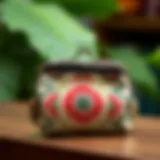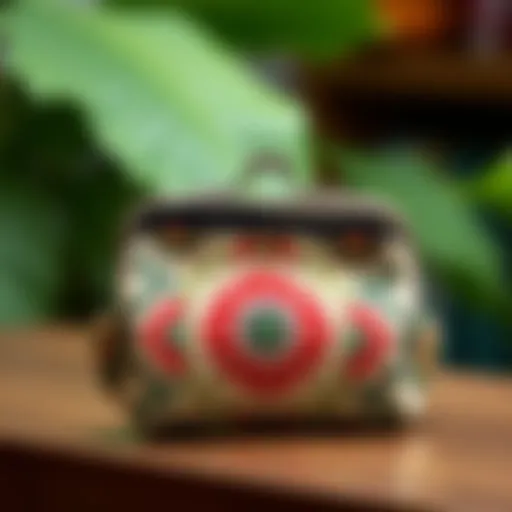Exploring the Enclosed Hammock: A Comprehensive Guide
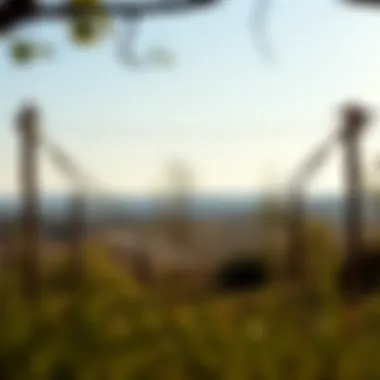

Intro
In the realm of outdoor and indoor relaxation, the enclosed hammock stands out as an innovative option that fuses comfort with practicality. Evolving from traditional designs, these hammocks offer a unique means of lounging, providing a cocoon-like space that shields users from the elements. Whether one is seeking solace by a serene lake or looking to unwind in the backyard, the enclosed hammock caters to a variety of settings and user preferences. This guide aims to unravel the various components that make the enclosed hammock a favored choice among both design enthusiasts and outdoor adventurers.
The significance of enclosed hammocks extends beyond mere leisure. They embody a shift in design philosophies that prioritize both form and function. As we navigate through this article, we will delve into key trends, material considerations, assembly techniques, and some thoughtful maintenance practices. With each section, the goal is to offer insights that empower readers to select and enjoy their enclosed hammocks to the fullest.
Fashion Trends
One could argue that enclosed hammocks are more than just versatile furniture; they are part of a fashion statement in the outdoor gear industry. The design of these hammocks has seen remarkable evolution, mirroring broader trends in sustainability, minimalism, and comfort.
Latest Seasonal Trends
As season changes, the design and functionality of enclosed hammocks also adapt. Recently, there’s been a noticeable move towards environmentally friendly materials. Manufacturers are increasingly using recycled fabrics and sustainable wood for frames. Additionally, colors that draw inspiration from nature—like muted greens and earthy browns—have gained popularity. These colors not only blend seamlessly into outdoor backgrounds but also appeal to consumers who are looking to reduce their carbon footprint.
The integration of technology into designs has also surged, with features such as integrated solar panels for lighting and USB charge ports becoming more common. Such advancements cater to the modern adventurer who seeks convenience combined with relaxation.
Iconic Styles Revived
Various designs, such as the classic Mayan and Brazilian hammocks, are seeing a resurgence. The retro vines and patterns, which were popular decades ago, add a nostalgic touch that many have found appealing. Such styles evoke a sense of simpler times while incorporating modern elements, thus bridging the gap between historical aesthetics and contemporary needs. This revival brings the allure of culture and history back into the outdoor space, offering consumers more than just a product—it's an experience.
"The hammock is not just a statement piece; it's a lifestyle choice, reflecting an appreciation for both style and the great outdoors."
Embracing both the practical design and the allure of timeless aesthetics, enclosed hammocks have become essential for those who wish to merge comfort with sophistication. Design enthusiasts, marketers, and even college students are starting to gravitate towards this trend—understanding that style can coexist with functionality.
From here, we'll explore essential style tips for incorporating enclosed hammocks into your lifestyle.
Understanding the Enclosed Hammock
The enclosed hammock represents a thoughtful evolution in the realm of outdoor and indoor relaxation. It's more than just a trend; it's a fusion of comfort, design, and practicality. Understanding what an enclosed hammock really is, and the intricacies involved, sets the foundation for appreciating its various applications and benefits. In a world increasingly focused on mobility and efficiency, these hammocks respond to the demand for a personal oasis—whether camping in the woods or snuggled up in the living room.
Definition and Purpose
An enclosed hammock can be defined as a suspended, protective cocoon designed to offer enhanced comfort while shielding the occupant from various environmental factors. The primary purpose is to create a private, secure space that envelopes the user. Here, a few key aspects come into play:
- Comfort: Enclosed hammocks boast a design tailored for coziness. The shape and materials work together to provide a supportive cradle, catering to a good night’s sleep or an afternoon nap.
- Protection: These hammocks generally include sidewalls and sometimes a roof, making them suitable against elements like rain, wind, or pesky insects. They allow for an outdoor experience without exposing the user to discomfort.
- Style: There’s an undeniable aesthetic appeal. An enclosed hammock can be a stylish addition to patios, backyards, or even indoor spaces, marrying functionality with design flair.
Whether for a short getaway in nature or permanent indoor fixtures, the appeal of an enclosed hammock lies in its multifunctionality and user-centric design.
Historical Context
The idea of a hammock dates back centuries; however, the concept of enclosing them is a relatively modern development. Hammocks originated in various cultures around the world as a practical sleeping solution. For instance, the indigenous peoples of the Caribbean utilized woven nets to suspend beds above the ground, protecting them from wildlife and moisture. This early functionality set the stage for innovation.
Fast forward to the 20th century, where the rise of camping and outdoor activities prompted developments in portable and more versatile designs. The innovation of the enclosed hammock emerged, combining traditional coziness with modern materials. It evolved with the inclusion of features such as insect netting and waterproof canopies, cementing its place in camping gear and home decor alike.
In essence, understanding the evolution of hammocks enriches our appreciation of enclosed versions today. It reflects not just a shift in utility but also a cultural journey—a transformation from traditional use into an element of leisure and lifestyle in the contemporary world.
Design Features of Enclosed Hammocks
The design features of enclosed hammocks are central to understanding their appeal and functionality. Unlike traditional hammocks, these enclosed variations offer an intricate blend of comfort, protection, and style, making them ideal for a range of environments. With more people looking toward outdoor experiences that mimic the comforts of home, the design elements of these hammocks are not just about aesthetics but practical details that enhance user experience.
Structural Composition
The structural composition of enclosed hammocks is one of the aspects that sets them apart. They typically consist of a sturdy frame, often made from lightweight aluminum or treated wood, paired with a robust fabric that can withstand various outdoor conditions. Most structures include a tensioning system that can keep the hammock taut without compromising on comfort. This configuration allows the occupant to feel secure while also achieving the slight bounce that a hammock is known for.
One popular structural feature is the incorporation of a self-supporting design. This helps avoid complicated setups that require tree mounts, making them suitable for both indoor and outdoor uses. Additionally, structural reinforcements at stress points can prevent sagging and enhance durability, allowing for versatile use across different terrains and weather conditions.
Material Variety
When discussing the material variety of enclosed hammocks, the focus shifts to the fabric, which plays a crucial role in determining their practicality and user experience. Many manufacturers now use high-quality, rip-resistant nylon or polyester fabrics that are easy to clean and maintain. These materials are also designed to be both lightweight and strong, providing an ideal balance for portability without sacrificing comfort.
Moreover, some enclosed hammocks feature UV-resistant fabrics that protect users from harmful sun exposure. This is particularly important for someone spending extended periods outdoors. On the insulation front, there are options utilizing breathable mesh layers that keep insects at bay while allowing for air circulation. This breathability can mean the difference between a cozy rest and a stifling snooze.
"An enclosed hammock is more than comfort; it is an intricate design freedom that allows you to redefine rest."
Ventilation and Protection
Ventilation and protection are two sides of the same coin when it comes to enclosed hammocks. A good design not only safeguards users against the elements—be it rain, wind, or insects—but also ensures that air moves freely to keep the occupant comfortable. Many enclosed hammocks offer mesh panels that provide excellent airflow while still offering surrounding protection.
Ultimately, an enclosed hammock should incorporate features like adjustable flaps or zippered openings. This allows users to control their exposure to the outside environment. These add-ons facilitate a customizable experience, letting you decide how much air you want—in other words, how enclosed or open you wish to feel at any given moment.
In summary, the design features of enclosed hammocks are multifaceted. They encompass structural integrity, diverse materials, and smart ventilation solutions—all tailored for an enhanced experience, whether you're out camping, enjoying the outdoors, or lounging at home. As such, selecting the right enclosed hammock boils down to personal needs while considering the clever engineering behind these modern relaxation tools.
Advantages of Using an Enclosed Hammock
The world of hammocks is vast, but the enclosed variety offers a unique set of advantages that cater to a spectrum of users. Beyond mere relaxation, enclosed hammocks provide significant benefits that enhance the overall experience, making them a worthwhile investment for anyone who values comfort and utility in outdoor or indoor settings. Understanding these advantages can help you make an informed choice, ensuring that your enclosed hammock serves your needs effectively.
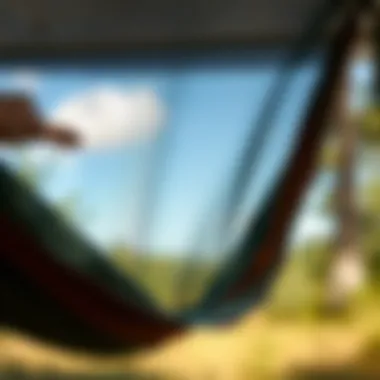

Enhanced Comfort
One of the primary reasons enthusiasts gravitate toward enclosed hammocks is the enhanced comfort they deliver. Unlike conventional hammocks, which can feel exposed and vulnerable, an enclosed hammock wraps you in a cocoon-like embrace. This design promotes a sense of security and tranquility that is often hard to find outdoors. The mesh panels provide enough airflow to keep you cool while also protecting from annoying bugs and insects.
The fabric used in these hammocks typically contributes to a luxurious feel, often crafted from soft, breathable materials. This means that when you’re curled up inside, you aren’t just resting—you’re truly relaxing. Consider it akin to diving into a fluffy cloud after a long day; the experience is markedly different than lying on a bare mat or standard hammock. Furthermore, many models come with added features like pillows or built-in cushioning, allowing users to create a personalized comfort zone.
Protection from Elements
Another hallmark feature of an enclosed hammock is its ability to provide protection from the elements. Whether you're camping in the wilderness or lounging in your backyard, the secure enclosure shields you from rain, wind, and harsh sunlight. It serves as a barrier against unexpected weather changes, thus ensuring that you can enjoy your hammock experience regardless of Mother Nature's whims.
Moreover, enclosed hammocks often come equipped with rainfly covers or built-in canopies. These additions are particularly valuable for intrepid campers and hikers. For instance, imagine setting up your hammock during a sunset camping trip, knowing that even if the clouds roll in, your cozy nook is fortified.
Additionally, they afford valuable protection against critters and insects that can disrupt your peace. This ensures not just comfort but safety as well.
Increased Privacy
In a world where the hustle and bustle never seem to cease, the increased privacy offered by enclosed hammocks cannot be overstated. These hammocks allow you to carve out a personal space that feels distinctly your own, even in crowded areas or during gatherings. When you slip inside, the outside world slightly fades away; this can be a sanctuary for those needing to take a moment away from social demands.
This aspect is especially beneficial for family use or public settings like parks or festivals. If you have kids or pets, setting up an enclosed hammock can create a safe and separate zone while still allowing them to be near you. Also, for those who enjoy practices like yoga or meditation, the snug confines help shield distractions, enabling a deeper focus.
The psychological impact of this privacy should not be underestimated. It encourages mindfulness and relaxation, allowing your body and mind to recharge more effectively.
Types of Enclosed Hammocks
When diving into the world of enclosed hammocks, it’s essential to recognize the variety that exists to cater to diverse preferences and needs. The significance of this topic cannot be overstated, as choosing the right type can greatly enhance your experience. Whether for camping, lounging at home, or accommodating the family, each type brings its own benefits and considerations to the table.
Camping Hammocks
Camping hammocks are a game changer for outdoor enthusiasts. Built with durability in mind, these hammocks often feature rip-resistant materials and robust stitching. When you're out in the wild, balancing weight and space is crucial. Many camping hammocks are designed to be lightweight while maintaining strength, making them handy for hiking trips.
Key features of camping hammocks include:
- Quick setup: Most models come with integrated straps or ropes that allow for easy assembly.
- Weather resistance: High-quality camping hammocks are treated to resist moisture and UV rays, which adds an extra layer of comfort while resting outdoors.
- Compact storage: Many fold down into a small pouch, easily fitting in a backpack without taking up too much room.
Choosing an adequate camping hammock can lead to a more enjoyable night’s sleep under starlit skies, far from the hassles of the ground.
Indoor Options
Indoor enclosed hammocks present a cozy sanctuary within the confines of your own home. Often, these versions come with added luxury elements, such as decorative designs or cozier fabrics. Their purpose usually leans more toward relaxation rather than portability, unlike their camping counterparts.
Some essential points to consider when picking an indoor hammock are:
- Aesthetic design: Many indoor hammocks are crafted to blend with your home decor, adding flair to your living space.
- Spatial requirements: Assess the available space; some models require ample room for a perfect setup, while others can fit snugly in corners.
- Comfort features: Indoor options may include pillows or padding, providing a more leisurely experience than traditional outdoor models.
Opting for an indoor hammock can transform a boring corner into a relaxing retreat, perfect for reading or simply taking a break from daily hustle.
Hammocks for Families
Family hammocks focus on inclusiveness, allowing multiple people to relax together. This type is generally more robust, constructed to support greater weight and withstand the playful antics of children.
Important attributes to keep in mind are:
- Size: Family hammocks typically boast larger dimensions, accommodating several users comfortably.
- Safety features: Look for hammocks with reinforced stitching and solid hanging systems to ensure the safety of all users.
- Versatility: These hammocks can serve multiple functions— from a swaying lounge spot during sunny afternoons to being a parent’s go-to napping nook.
Choosing the right family hammock means investing in an item that nurtures shared moments, allowing both adults and kids to enjoy the simple joy of swinging together.
When you think about the types of enclosed hammocks, remember that each one serves a different niche, ensuring there’s a perfect match for your specific needs.
Selecting the Right Enclosed Hammock
Choosing the right enclosed hammock is crucial for maximizing your comfort and safety. It’s not just about aesthetics; the right choice can enhance your experience whether you’re lounging in your backyard, hiking through a forest, or setting up camp near a serene lake. This section emphasizes key factors you should consider to ensure your enclosed hammock meets your needs.
Size Considerations
When selecting an enclosed hammock, size really does matter. The dimensions should cater to the users: think about the height and the room available for stretching. If you're taller than average, a longer model might be your best bet to prevent feeling cramped. Width is equally important; a hammock that’s too narrow can make even the most peaceful nap feel like a wrestling match with the fabric.
"A well-sized hammock is like a hug from nature. Too tight and it constricts, too loose and it loses its purpose!"
Some models come with adjustable features, which can be beneficial for those who want versatility. You might also want to consider how you'll use it. Will it be a solo retreat, or are you planning for family outings? A double hammock can comfortably accommodate two, while still allowing plenty of stretching room.
Weight Capacity
Next, let’s talk weight capacity. Each hammock is rated for a maximum load, and exceeding this limit can result in disastrous consequences. It’s critical to look at both the hammock’s total capacity and the specific weight limit it can support.
Consider the combined weight of yourself, your gear, and anything else you might bring along. It’s often wise to choose a hammock with a weight limit higher than what you expect to carry. Not only does this help with durability, but it also provides peace of mind, knowing that you're well within safe limits.
Budgeting for Quality
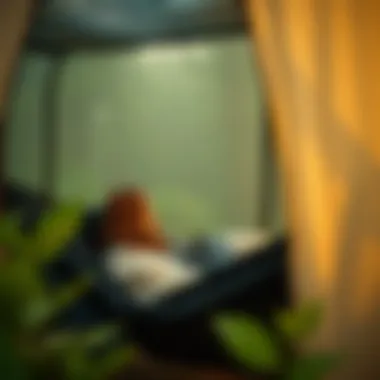
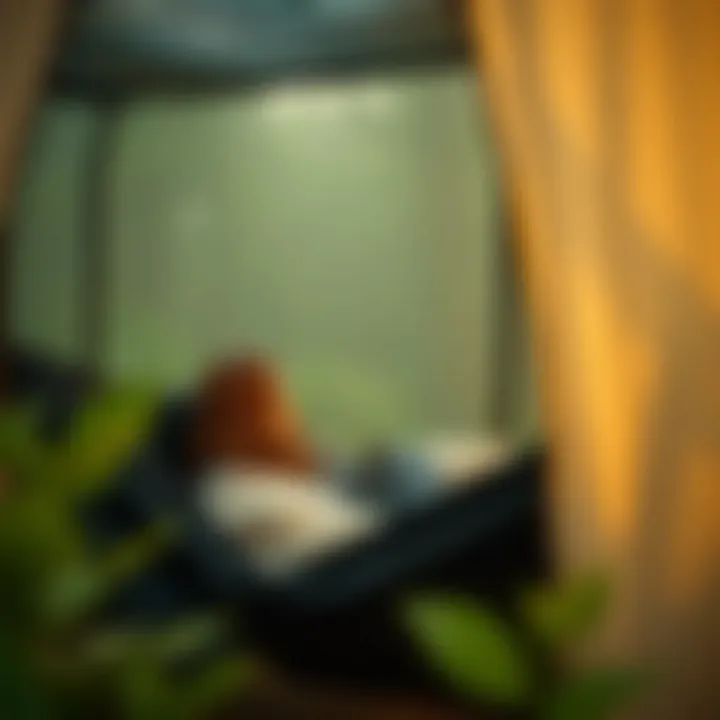
Budget plays a significant role in the selection process. However, it’s essential to view your investment as long-term rather than just a simple purchase. A high-quality enclosed hammock might cost a bit more initially, but its durability and comfort often outweigh its price tag.
When setting your budget, consider the materials used. Hammocks made with higher-grade nylon or breathable polyester can greatly affect the overall experience, particularly in humid conditions. An integrated bug net or water-resistant features often signal quality, showcasing the manufacturer’s commitment to functionality.
- Lower Budget Options: May suffice for occasional use but likely lack durability.
- Mid-Range Pricing: Usually offers good quality, and various features without breaking the bank.
- High-End Choices: Tend to be exceptionally durable, lightweight, and comfortable. They often come with warranties that add further value.
In a nutshell, choosing the right enclosed hammock requires thoughtfulness and consideration to ensure it aligns with your lifestyle and specific needs. The most suitable choice can make your relaxation time more enjoyable while equipping you for any adventure, outdoor or indoor.
Setting Up an Enclosed Hammock
Setting up an enclosed hammock is an essential skill for anyone looking to enhance their outdoor adventures or enjoy relaxing moments in their backyard. The process may seem simple at first glance, but it encompasses various elements that contribute significantly to the hammock's overall performance and user experience. Choosing the right location, employing proper assembly techniques, and conducting safety checks before use are pivotal steps that can make or break your lounging experience. Here's a closer look at each of these aspects.
Choosing the Right Location
When it comes to getting the most out of your enclosed hammock, the location is king. You wouldn't want to set up your relaxation station in a windy zone or somewhere close to a busy path. Ideally, seek a spot that is protected from the elements, like trees or structures that can offer some shelter from wind and sun. Look for level ground that is free from sharp rocks and debris, as these can damage your hammock and even pose a risk of injury.
Considerations for Location:
- Proximity to Trees: Look for sturdy trees at an appropriate distance to minimize stress on the hammock. Trees should ideally be about 12 to 15 feet apart for optimal tension.
- Ground Conditions: Soft, sandy, or grassy areas are best; they cushion falls should anything go awry.
- Visibility: Decide if you want seclusion for privacy or visibility for a social setting.
Establishing a good location not only augments comfort, but it also fosters a better mood and enhances the entire hammock experience.
Assembly Techniques
After you’ve chosen your spot, the next step is the assembly of your enclosed hammock. A critical component that novices often overlook is the method of attachment. In general, using high-quality straps designed specifically for hammocks will help distribute weight evenly and protect the tree bark.
To set it up correctly, follow these basic steps:
- Attach the Straps: Securely wrap the strap around the tree at least 4-5 feet above the ground. It's crucial that they are not too tight or too loose, as both can lead to unforeseen issues.
- Choose the Right Angle: When hanging, aim for about a 30-degree angle from the horizontal. The angle influences how comfortable the hammock feels and minimizes the risk of tipping.
- Check the Foot and Head Ends: Make sure that both ends are at a similar height to avoid slippage.
To wrap it all up, a bit of patience and precision goes a long way in assembly, leaving you to relish the comfort of your enclosed hammock.
Safety Checks Before Use
Last but certainly not least, conducting safety checks is non-negotiable. It may feel like an afterthought, but skipping this step could have disastrous consequences. Here’s how to ensure a safe experience:
- Inspect the Straps and Ties: Check for frays or weakened areas that could compromise stability.
- Test Weight Capacity: Give the hammock a gentle tug and check its sturdiness before fully committing your weight. Better safe than sorry, right?
- Confirm Clearance: Make sure there’s ample space below to avoid accidents. No one wants to faceplant on the ground!
"An ounce of prevention is worth a pound of cure."
Following these aspects will bridge the gap between a subpar experience and one that leaves you feeling refreshed and ready to take on the world. By paying attention to your hammock's setup, you lay the foundation for memorable moments geared towards relaxation, adventure, and everything in between.
Maintaining Your Enclosed Hammock
When it comes to making the most out of your enclosed hammock experience, maintaining your investment is paramount. Like any gear you cherish, proper care extends its lifespan and enhances its usability. Many people buy hammocks for relaxation and outdoor fun, but it’s easy to overlook maintenance amid such enjoyable activities. Understanding how to keep your enclosed hammock in tip-top shape will ensure that you can enjoy countless sun-soaked afternoons swaying beneath a leafy canopy or serene nights watching the stars.
Cleaning Practices
Cleaning your enclosed hammock is a fundamental aspect of maintenance that shouldn't be taken lightly. Dirt, debris, and moisture can accumulate over time, potentially leading to mold, mildew, or fabric degradation. Regular cleaning prolongs its life while ensuring you can enjoy that peaceful lounge without itching from bugs or irritation from grime. Here's how to do it right:
- Gentle Hand Washing: Use mild soap and tepid water. Submerge and scrub lightly; don’t wring it out, which can damage the fabric.
- Machine Washing: If the hammock label permits, wash it on a gentle cycle in cold water. Make sure to remove any attached accessories first.
- Air Drying: Avoid the dryer, as heat can warp structure and color. Hang it, if possible, out of direct sunlight to maintain its color and integrity.
By establishing a routine cleaning schedule, say every few weeks or more frequently if you’ve been on a muddy trail, you won’t find yourself with a grimy hammock that nobody wants to sit in.
Storage Solutions
When the day comes to pack up your enclosed hammock, storage can make all the difference in its longevity. Improper storage can lead to creasing, moisture accumulation, and potential pest infiltration. Here are some savvy solutions to keep your hammock fresh until next use:
- Use a Hammock Tree: For long-term storage, keep it stretched if possible to avoid creases. A hammock tree maintains the shape and avoids folds that can damage fabrics.
- Breathable Storage Bags: Invest in a breathable storage bag, which allows air circulation while protecting it from dust and pests. Avoid plastic, as it traps moisture.
- Dry Before Storing: Ensure your hammock is entirely dry before storing to eliminate any risk of mold and mildew forming.
With these techniques, you can tuck your hammock away and know it will be ready when your next adventure calls.
Inspecting for Wear and Tear
An enclosed hammock is not just a piece of fabric; it's an investment in comfort and leisure. Regularly inspecting it for wear and tear is necessary to keep enjoying it safely. Any signs of fraying, loose seams, or faded color could indicate it's time for repairs or replacement. Keep an eye out for these important aspects:
- Sewing Integrity: Check stitching regularly. If you spot loose threads, take the time to fix them, either by hand or with a sewing machine.
- Material Condition: Look for thin areas or tiny holes. These could weaken when under weight. If the fabrics are compromised, it might be time for an upgrade.
- Suspension System: Inspect straps and carabiners for signs of wear or rust. These components are key to your safety—don’t overlook them!
A stitch in time saves nine; investing a bit of effort in your hammock’s upkeep can save you from regretting the day you overlooked a tear or weak point.
By following these simple yet effective maintenance strategies, you can ensure your enclosed hammock remains a reliable companion for years to come.
Innovative Uses of Enclosed Hammocks
The enclosed hammock isn't just a beautiful piece of outdoor furniture; it's a functional tool that can radically enhance various activities. Understanding its innovative applications can open doors to new experiences. Whether for leisure activities, wellness practices, or even pet care, there are numerous ways to utilize an enclosed hammock effectively and enjoyably.


Outdoor Adventure
For many lovers of the great outdoors, an enclosed hammock offers a unique form of rest and relaxation while exploring nature. Unlike traditional hammocks that may leave one exposed to insects and elements, enclosed hammocks provide a secure sanctuary. This means less worry about pesky mosquitoes buzzing in your ear or rain drenching your nap.
When embarking on a hiking trip or camping adventure, the enclosed hammock stands out as a lightweight, portable haven. It can easily be packed into a backpack and set up in a matter of minutes. Additionally, due to its design, it can be hung between trees or other sturdy structures, adding to its versatility.
Imagine straying from the beaten path, discovering a remote spot by a lake or in a serene forest, and setting up your enclosed hammock. While your pals attempt to pitch a tent, you’re already settling in, enjoying the gentle sway as you take in the surroundings. The cocoon-like structure not only enhances comfort but also fosters a sense of peace, allowing adventurers to truly connect with their environment.
Yoga and Meditation
The enclosed hammock isn’t only for adventurers; it's also an excellent tool for those pursuing mindfulness and wellness. Practicing yoga or meditation in an enclosed hammock creates a soothing environment that fosters concentration and relaxation.
Suspended above the ground, the hammock envelops you, providing stability and warmth. This secure feeling can improve the quality of your practice by allowing for deeper stretches and enhancing relaxation during certain poses. It's like floating gently on a cloud—offering an ethereal experience that ground techniques alone cannot provide.
Moreover, it allows for a unique twist on traditional yoga routines. Try incorporating inversions or gentle sways in your practice, as the hammock supports weight and movement.
For those meditating, the enclosed layer cuts off external distractions, helping focus energy inward. Whether you're practicing mindfulness in a park or a cozy corner of your home, the enclosed hammock is a haven for those seeking tranquility and clarity.
Pet Use Cases
Enclosed hammocks are not just beneficial for humans; they can offer a comfortable retreat for pets too. Many pet owners are turning to this versatile gear for a secure spot for their animals.
For instance, small dogs or cats enjoy curling up in an enclosed hammock. Elevated off the ground, pets feel safe from outdoor elements and can nap undisturbed. This can be especially helpful during camping trips, where pets can be at risk from insects or other wildlife.
Using an enclosed hammock for pets can also encourage them to relax. Just like humans, animals benefit from having a designated space that feels secure. Moreover, these hammocks often come with durable materials making them easy to clean after a day full of play.
Sustainable Practices in Hammock Production
Sustainable production practices are becoming ever more crucial in today's world, particularly in the consumer goods industry, which includes products like enclosed hammocks. The impact of making products on the environment can be significant, so it's essential for manufacturers and consumers alike to consider sustainable practices. This section highlights material sourcing, manufacturing processes, and the lifecycle of hammocks, shedding light on the interplay between design, the environment, and ethical considerations.
Material Sourcing
When talking about materials for hammocks, sustainability has to be front and center. Natural fibers like organic cotton or bamboo are often favored over synthetic materials such as polyester or nylon, which can take centuries to decompose. Sourcing natural materials reduces harmful landfill waste and is generally more eco-friendly.
Additional benefits include:
- Reduced Carbon Footprint: Organic materials often don’t use harmful pesticides or fertilizers.
- Biodegradability: Natural fibers break down over time, causing less environmental harm.
- Support for Local Economies: Choosing locally sourced materials can empower communities and decrease transportation emissions.
Using standardized benchmarks, manufacturers who prioritize eco-conscious material sourcing can be more persuasive in marketing their products to a discerning audience that values environmental stewardship.
Manufacturing Processes
Just as important as sourcing is the method of manufacturing. Many cutting-edge companies now adopt practices that trim down energy consumption. For example, they might use solar power, water recycling, or eco-friendly dyes that are free from harmful chemicals. The legitimacy of these practices not only gives businesses a leg up on their competition but also caters to a customer base increasingly interested in the ethical ramifications of their purchases.
Some noteworthy processes include:
- Energy-efficient production technologies: These minimize electricity and water use.
- Waste recycling: Scraps can often be reused in new products or repurposed entirely.
- Low-impact dyes: Chemical-free methods can lead to vibrant colors without the environmental risk.
In an age where companies are closely scrutinized for their environmental impact, integrating sustainable manufacturing practices is a smart choice for brand identity. A clear commitment to sustainability can attract a loyal clientele who are passionate about supporting responsible brands.
Lifecycle of Hammocks
Understanding the lifecycle of a hammock can illuminate how sustainable practices impact the overall product. From production through to end-of-life, each phase offers opportunities for eco-friendly choices. Ideally, a hammock should be designed for durability, allowing it to serve its purpose over many years. This longevity minimizes waste and maximizes consumer satisfaction.
Key aspects involve:
- Durability: High-quality materials reduce the need for replacements.
- End-of-life options: Brands should inform consumers about how to recycle or dispose of their hammocks responsibly. This could include take-back programs or partnerships with recycling centers.
- Second-life possibilities: Some companies design hammocks to easily convert into other products once their primary use is finished.
By focusing on the entire lifecycle of their products, manufacturers can instill a sense of environmental responsibility both in their practices and in the minds of consumers.
Future Trends in Enclosed Hammocks
As the world evolves, so too does our appreciation for leisure and outdoor activities. Enclosed hammocks are becoming more than mere relaxation tools; they are adapting to meet changing consumer needs and technological advancements. Understanding the upcoming trends in enclosed hammocks is crucial for designers, manufacturers, and enthusiasts alike. The following insights delve into how these trends impact functionality, comfort, and overall use.
Technological Advancements
The future of enclosed hammocks is tightly woven with technology. Innovations in materials and design are paving the way for products that are sturdier, lighter, and more comfortable. For instance, advancements in synthetic fabrics now allow for greater breathability while also being water-resistant. These textiles can withstand sun, rain, and wind without degrading, making them perfect for outdoor enthusiasts.
Smart technology is also starting to make waves. Imagine an enclosed hammock equipped with a built-in climate control system that maintains the perfect temperature inside regardless of external conditions. Sensors can monitor the environment and adjust the interior's heat or coolness, enhancing comfort significantly.
Moreover, attention to detail in the structural design is paramount. Brands are testing hybrid designs that integrate traditional floor-less designs with more stable bases, allowing users to enjoy both versatility and security. Such innovations could redefine the hammock experience, turning it into a fully immersive retreat from the outside world.
Market Growth Insights
The interest in enclosed hammocks isn't simply a passing trend; it's indicative of broader consumer behaviors in outdoor recreation. Recent reports show that the outdoor recreational market has been steadily growing, with more individuals seeking unique experiences in nature. This trend reflects a shift towards self-care and the desire for outdoor relaxation spaces, where enclosed hammocks fit in perfectly.
Furthermore, sales of these hammocks among urban dwellers are witnessing a notable uptick. As urbanization continues, people are craving ways to connect with nature even within the confines of their city life. Enclosed hammocks offer a simple solution for a personal getaway, whether it be in a backyard or a small park.
The market for environmentally-friendly products is also expanding. With increasing awareness about climate change, consumers are gravitating towards brands that employ sustainable practices. Companies that prioritize eco-friendly materials and transparent manufacturing processes will likely see an edge in this competitive market.
"The future of enclosed hammocks lies not just in their design but also in how they connect people to nature and their individual well-being.”
In summary, the trends in enclosed hammocks are poised to elevate not just product features, but also the overall experience for users. By embracing technological advancements and responding to market demands, manufacturers can develop hammocks that resonate with the modern user, who values both comfort and connection to the world around them. The intersection of practicality and sustainability will be key in shaping the future of this unique outdoor gear.


